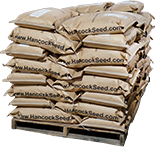Indiangrass is a warm season bunchgrass, native to most of the United States. It spreads by seed and scaly underground rhizomes. This perennial produces a tall, robust, vigorous plant, 3 to 8 ft. tall, with wide blue-green leaves and panicles 8 to 12 in. long, which are bronze in color.
Product Information
- Application or Use: Pasture, Cattle Grazing, Livestock Forage, Food Plot, Erosion Control, Pollinators
- Germination Time: 14 - 21 days, under optimal conditions. Allow 3-4 weeks for the unstratified seed to break dormancy and germinate, under optimal conditions.
- Growing Locations: Warm Season & Transition Zone
- Height: 3 - 7 feet
- Sunlight Requirements: 6 - 8 hours, full sun for best results
- Advantages: Produces a tall, robust, vigorous plant with high palatability.
- When to Plant: Recommended planting time is spring and summer when night time temperatures are consistently 65+ degrees and after last chance of frost.
Product Details
- Cold and drought resistant
- Produces a tall, robust, vigorous plant
- High palatability
- Good grazing management is necessary
- Grows in a wide variety of soil types and soil moisture
Product Information
Indiangrass is both cold and drought resistant. Because of its high palatability, good grazing management is necessary. Limit grazing until a good stand of plants 10 to 12 in. tall are established. Excellent hay may be cut when the seed heads are in the boot stage.
Normally it is not found as a dominant species but is considered a valuable grass in blends, and should be used in reseeding on range sites.
*Product packaging may appear different than what is pictured.

The seed is chaffy, and special grass drills developed for this type of seed should be used. Drill the seed at 1/4 inch in moist, fine textured soils and 3/4 inch in drier, looser and coarser soil conditions. Planting should take place in the spring. Dormant seedings after November 1st have proven very successful. Range seedings of Indiangrass are seldom used alone.
Generally, spring is the best time of the year to plant. Indiangrass can be found on prairies, bottomlands, and in all soil textures throughout the eastern half of the United States, as well as the desert southwest. There are several varieties but the more popular varieties are "Cheyenne," "Lometa," "Osage," "Rumsey" and "Oto."
Indiangrass Native Grass Seed
Indiangrass is a warm season bunchgrass, native to most of the United States. It spreads by seed and scaly underground rhizomes. This perennial produces a tall, robust, vigorous plant, 3 to 8 ft. tall, with wide blue-green leaves and panicles 8 to 12 in. long, which are bronze in color.

Instructions
For more info on planting instructions and tips for the best results – check out our Warranty & Planting Information here!
The seed is chaffy, and special grass drills developed for this type of seed should be used. Drill the seed at 1/4 inch in moist, fine textured soils and 3/4 inch in drier, looser and coarser soil conditions. Planting should take...






























